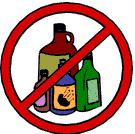
|
Adolescents: Treatment For Substance Use Disorders |
A continuing education course for 8 ces
consisting
of reading and taking a post-test on
Treatment of Adolescents With Substance Use Disorders
Treatment Improvement Protocol (TIP) Series 32
Fulfills CA BBS mandatory substance abuse training and mandated prelicensure
requirement |
Excerpt: Substance Use Disorder Treatment and Adolescents In 1997, substance use among 12- to 17-year-old children rose to 11.4 percent with illicit drug use among 12- and 13-year-olds increasing from 2.2 to 3.8 percent, according to the 1997 National Household Survey on Drug Abuse conducted by the Substance Abuse and Mental Health Services Administration. Moreover, perceived risk of harm from substance use is falling while the availability of drugs is climbing. These trends indicate a major national problem, especially as the social and economic costs of adolescent substance use are becoming better understood. The onset of substance use is occurring at younger ages, resulting in more adolescents entering treatment for substance use disorders with greater developmental deficits and perhaps much greater neurological deficits than have been observed in the past. Other consequences of substance use and abuse include alcohol- and drug-related traffic accidents, delinquency, sexually risky behavior, and psychiatric disorders. Adolescent users differ from adults in many ways. Their drug and alcohol use often stems from different causes, and they have even more trouble projecting the consequences of their use into the future. In treatment, adolescents must be approached differently than adults because of their unique developmental issues, differences in their values and belief systems, and environmental considerations (e.g., strong peer influences). At a physical level, adolescents tend to have smaller body sizes and lower tolerances, putting them at greater risk for alcohol-related problems even at lower levels of consumption. The use of substances may also compromise an adolescent's mental and emotional development from youth to adulthood because substance use interferes with how people approach and experience interactions. The treatment process must address the nuances of each adolescent's experience, including cognitive, emotional, physical, social, and moral development. An understanding of these changes will help treatment providers grasp why an adolescent uses substances and how substance use may become an integral part of an adolescent's identity. Regardless of which specific model is used in treating young people, there are several points to remember when providing substance use disorder treatment: In addition to age, treatment for adolescents must take into account gender, ethnicity, disability status, stage of readiness to change, and cultural background. Some delay in normal cognitive and social-emotional development is often associated with substance use during adolescence. Treatment for adolescents should identify such delays and their connections to academic performance, self-esteem, or social interactions. Programs should make every effort to involve the adolescent client's family because of its possible role in the origins of the problem and its ability to change the youth's environment. Although it may be necessary in certain geographic areas where availability of adolescent treatment programs is limited, using adult programs for treating youth is ill-advised. If this must occur, it should be done only with great caution and with alertness to inherent complications that may threaten effective treatment for these young people. Many adolescents have explicitly or implicitly been coerced into attending treatment. Coercive pressure to seek treatment is not generally conducive to the behavior change process. Treatment providers should be sensitive to motivational barriers to change at the outset of intervention. Several strategies can be used for engaging reluctant clients to consider behavioral change. Tailoring Treatment to The Adolescent Adolescent substance use occurs with varying degrees of severity. The degree of substance involvement is an important determinant of treatment, as are any coexisting disorders, the family and peer environment, and the individual's stage of mental and emotional development. |

This TIP, Treatment of Adolescents With Substance Use Disorders, updates
TIP 4, published in 1993, and presents
information on substance use disorder treatment for adolescent clients.
Adolescents differ from adults both
physiologically and emotionally as they make the transition from child
to adult and, thus, require treatment adapted to
their needs. The onset of substance use is occurring at younger ages,
resulting in more adolescents entering treatment
for substance use disorders than has been observed in the past. In order
to treat this population effectively, treatment
providers must address the issues that play significant roles in an adolescent's
life, such as cognitive, emotional,
physical, social, and moral development, and family and peer environment.
This TIP focuses on ways to specialize
treatment for adolescents, as well as on common and effective program
components and approaches being used today.
Chapter 1 details the scope and complexity of the problem; |

| What Is a TIP? Treatment Improvement Protocols (TIPs) are best practice guidelines for the treatment of substance use disorders, provided as a service of the Substance Abuse and Mental Health Services Administration's (SAMHSA) Center for Substance Abuse Treatment (CSAT). CSAT's Office of Evaluation, Scientific Analysis and Synthesis draws on the experience and knowledge of clinical, research, and administrative experts to produce the TIPs, which are distributed to a growing number of facilities and individuals across the country. The audience for the TIPs is expanding beyond public and private treatment facilities for substance use disorders as substance use disorders are increasingly recognized as a major problem. |
maintains responsibility for the program. |
Learning Objectives 1. Recognize the 'red flags', for assessment, detection,
and signs of adolescent
substance abuse.
|
This course consists of reading and taking a post-test on:
Treatment
Improvement Protocol (TIP) Series 32
Ken C. Winters, Ph.D. Revision Consensus Panel Chair
U.S. DEPARTMENT OF HEALTH AND HUMAN SERVICES
Public Health Service
Substance Abuse and Mental Health Services Administration
Center for Substance Abuse Treatment
Rockwall II, 5600 Fishers Lane
Rockville, MD 20857
DHHS Publication No. (SMA) 99-3283
All material appearing in this volume except that taken directly from copyrighted sources is in the public domain and may be reproduced or copied without permission from the Substance Abuse and Mental Health Services Administration's (SAMHSA) Center for Substance Abuse Treatment (CSAT) or the authors. Citation of the source is appreciated.
Cost
of the 8 unit course is $88
We do adhere to the American Psychological Association's Ethical Principles of Psychologists. Our courses are carefully screened by the Planning Committee to adhere to APA standards. We also require authors who compose Internet courses specifically for us follow APA ethical standards. Many of our courses contain case material, and may use the methods of qualitative research and analysis, in-depth interviews and ethnographic studies. The psychotherapeutic techniques depicted may include play therapy, sandplay therapy, dream analysis, drawing analysis, client and therapist self-report, etc. The materials presented may be considered non-traditional and may be controversial, and may not have widespread endorsement within the profession. www.psychceu.com maintains responsibility for the program and its content. |
All material included in this course is either in the public domain, or used with express permission. |
|
Thank you! |
888-777-3773
|
|

|


